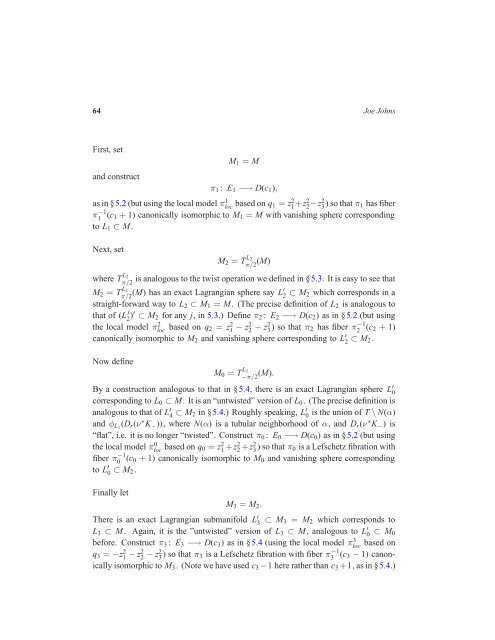The Picard-Lefschetz theory of complexified Morse functions 1 ...
The Picard-Lefschetz theory of complexified Morse functions 1 ...
The Picard-Lefschetz theory of complexified Morse functions 1 ...
You also want an ePaper? Increase the reach of your titles
YUMPU automatically turns print PDFs into web optimized ePapers that Google loves.
64 Joe Johns<br />
First, set<br />
and construct<br />
M1 = M<br />
π1 : E1 −→ D(c1),<br />
as in §5.2 (but using the local model π 1 loc based on q1 = z 2 1 +z2 2 −z2 3 ) so that π1 has fiber<br />
π −1<br />
1 (c1 + 1) canonically isomorphic to M1 = M with vanishing sphere corresponding<br />
to L1 ⊂ M.<br />
Next, set<br />
M2 = T L2<br />
π/2 (M)<br />
where T L2<br />
π/2 is analogous to the twist operation we defined in §5.3. It is easy to see that<br />
M2 = T L2<br />
π/2 (M) has an exact Lagrangian sphere say L′ 2 ⊂ M2 which corresponds in a<br />
straight-forward way to L2 ⊂ M1 = M. (<strong>The</strong> precise definition <strong>of</strong> L2 is analogous to<br />
that <strong>of</strong> (L j<br />
2 )′ ⊂ M2 for any j, in 5.3.) Define π2 : E2 −→ D(c2) as in §5.2 (but using<br />
the local model π2 loc based on q2 = z2 1 − z22 − z23 ) so that π2 has fiber π −1<br />
2 (c2 + 1)<br />
canonically isomorphic to M2 and vanishing sphere corresponding to L ′ 2 ⊂ M2.<br />
Now define<br />
M0 = T L1<br />
−π/2 (M).<br />
By a construction analogous to that in §5.4, there is an exact Lagrangian sphere L ′ 0<br />
corresponding to L0 ⊂ M. It is an “untwisted” version <strong>of</strong> L0. (<strong>The</strong> precise definition is<br />
is the union <strong>of</strong> T \ N(α)<br />
analogous to that <strong>of</strong> L ′ 4 ⊂ M2 in §5.4.) Roughly speaking, L ′ 0<br />
and φL1 (Dr(ν ∗K−)), where N(α) is a tubular neighborhood <strong>of</strong> α, and Dr(ν ∗K−) is<br />
“flat”, i.e. it is no longer “twisted”. Construct π0 : E0 −→ D(c0) as in §5.2 (but using<br />
the local model π0 loc based on q0 = z2 1 +z22 +z23 ) so that π0 is a <strong>Lefschetz</strong> fibration with<br />
fiber π −1<br />
0 (c0 + 1) canonically isomorphic to M0 and vanishing sphere corresponding<br />
to L ′ 0 ⊂ M2.<br />
Finally let<br />
M3 = M2.<br />
<strong>The</strong>re is an exact Lagrangian submanifold L ′ 3 ⊂ M3 = M2 which corresponds to<br />
L3 ⊂ M. Again, it is the ”untwisted” version <strong>of</strong> L3 ⊂ M, analogous to L ′ 0 ⊂ M0<br />
before. Construct π3 : E3 −→ D(c3) as in §5.4 (using the local model π3 loc based on<br />
q3 = −z2 1 − z22 − z23 ) so that π3 is a <strong>Lefschetz</strong> fibration with fiber π −1<br />
3 (c3 − 1) canonically<br />
isomorphic to M3. (Note we have used c3 −1 here rather than c3+1, as in §5.4.)
















